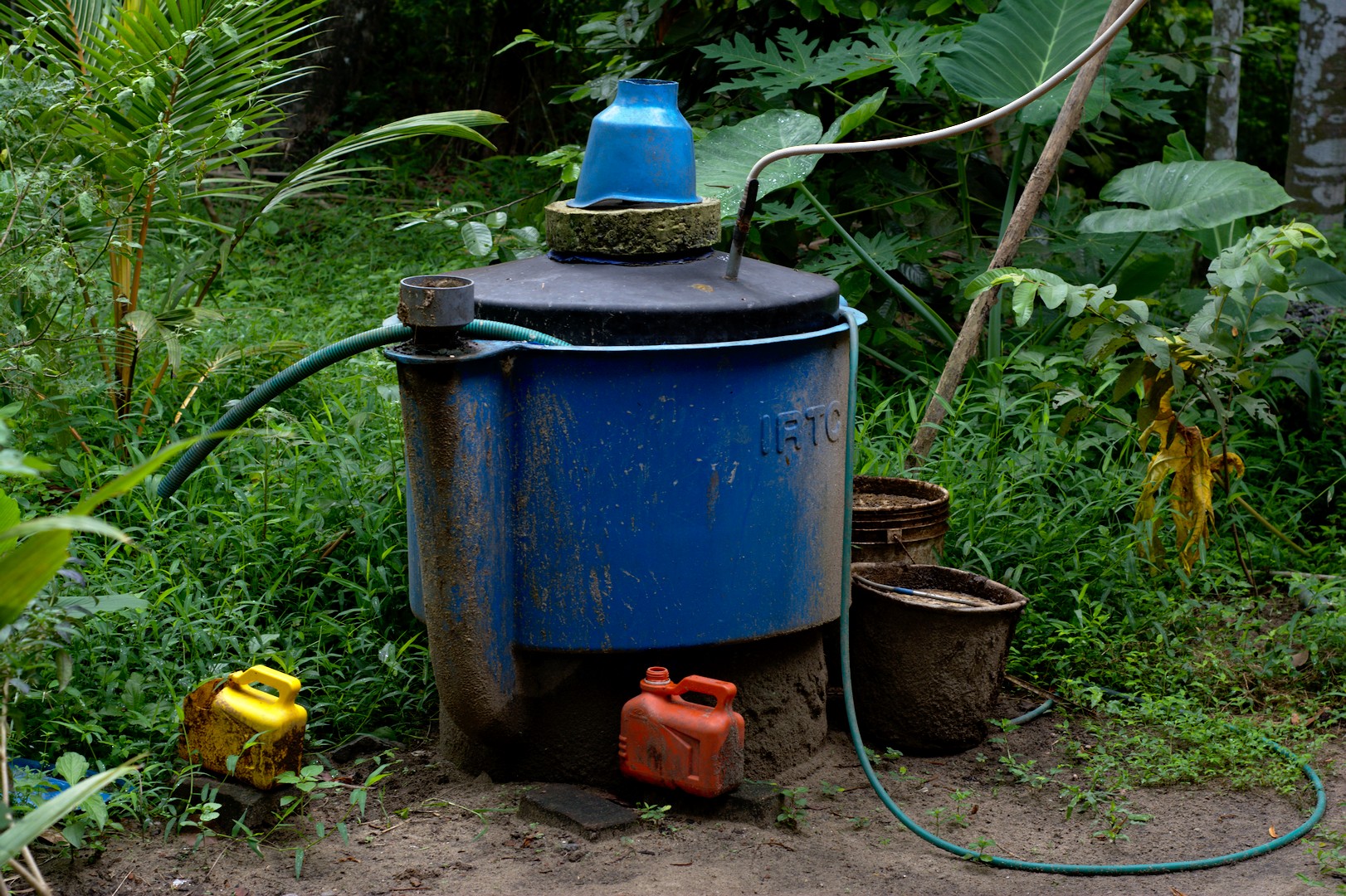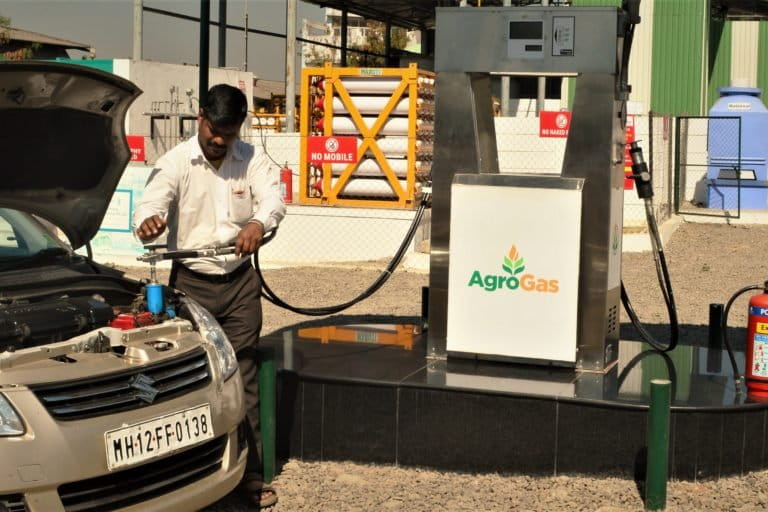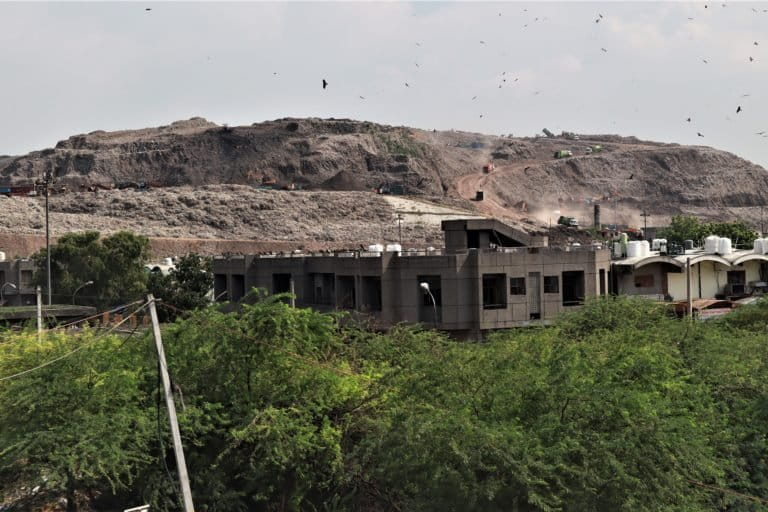- Energy experts claim that compressed biogas could become the fuel of the future due to its virtue of being a clean and renewable source of energy, which is also indigenous. It is also expected to reduce the cost of imports of natural gas.
- India currently hosts Asia’s largest compressed biogas plant at Sangrur in Punjab, while other small and medium-scale plants also exist that produce this compressed biogas or bio-CNG for vehicles and other uses. Big corporates are also now expected to invest crores in the biogas business.
- The infrastructure for gas is readily available in India. Financial assistance and strict waste segregation and management rules could help the industry grow and meet the energy demands of the country, according to the experts.
In the second week of August this year, the Punjab government announced that it has started the commercial production of compressed biogas (CBG) from a plant at Bhuttan Kalan, a village in the Sangrur district. It is said to be Asia’s largest compressed biogas plant with an estimated production capacity of 33.23 tonnes per day. The Punjab Energy Development Agency (PEDA), a state nodal agency for the promotion and development of renewable energy programmes, is also said to have allocated 42 other CBG plants which together can produce 492.58 tonnes of compressed biogas per day. This compressed biogas produced in these plants is derived from the agricultural residues and other organic sources which had been a cause of concern in Punjab due to stubble burning and related air pollution.
Biogas is fuel produced by the anaerobic decomposition of organic waste such as agricultural waste, plant waste and organic municipal waste. Compressed biogas (CBG) is then produced by further processing of biogas in which other gases like carbon dioxide are reduced and methane is maintained at more than 90 percent quantity. CBG primarily contains methane, a limited amount of carbon dioxide, nitrous oxide and traces of other compounds. CBG is also referred to as bio-CNG and could be directly used in vehicles that usually use CNG or compressed natural gas which is a fossil fuel. CBG is also used as an alternative to natural gas for cooking and in other industries like cement and steel.
Earlier this year, Prime Minister Narendra Modi inaugurated one of India’s biggest CBG (bio-CNG) plants at Indore in Madhya Pradesh, named Gobar-Dhan, which has the capacity to process 550 tonnes of waste and produce 17,000 kilograms of bio-CNG each day. The Indore Municipal Corporation (IMC) has also tied up with Gobar-Dhan and has assured the purchase of 50 percent of the fuel to run its CNG buses. IMC has also promised to provide sufficient segregated waste to the plant to ensure adequate feedstock for its biogas production.
Apart from all the state-specific investments which provide a major boost to the sector, leading corporate houses Reliance Industries and Adani New Industries Limited (ANIL) have also planned to invest Rs. 500-600 crores each in the sector, according to media reports. While ANIL reportedly plans to use its existing city-based gas network to use CBG in cooking fuel, Reliance Industries is expected to use its fuel outlets in India, for automobiles. However, the companies are yet to make official announcements regarding their investments.
Experts who closely monitor the energy sector state that the recent interest in CBG is mostly due to the increased awareness and the very virtue of it being an indigenous and a clean energy source. The government’s push with the policies and schemes seems to have given the sector an impetus. However, the sector also has its own inherent challenges.

A promising market
Brajesh Singh is the President of Arthur D. Little, India, a global management consultancy. Singh says he believes that the increased awareness and policy thrust post 2017, have given a boost to the sector. He told Mongabay-India, “Due to its higher calorific value (5,000 kcal per cubic per meter), biogas-CNG is an affordable, sustainable and an environment-friendly alternative for fuel. Advanced technologies help purify the composition of methane, carbon dioxide and other components as ammonia, hydrogen and sulphur, help make it good for domestic and commercial uses.”
He also added, “India is estimated to be a $2.5 billion market by 2030 for CBG, with about 4,100 CNG gas stations. Heavy industries such as chemical and fertilisers, manufacturing and real estate, shopping malls and similar sectors are bigger consumers of gas as fuel and they are contemplating an alternate sustainable solution.”
‘CBG is the fuel of the future’
Although the current contribution of biogas or compressed biogas is not very significant in India’s clean energy mix, the future seems to be promising. According to estimates from the Ministry of New and Renewable Energy (MNRE), with the treatment of municipal waste in India, the country has the potential to generate 1.5 Metric Tonnes Per Annum (MTPA) of CBG or bio-CNG.
When asked about the likely future of the bio-CNG market in India, Atul Akolkar told Mongabay-India, “Bio-CNG is going to be the fuel of the future for India which can not only help the country in reducing its import costs on natural gas but help in solving multiple problems like processing agricultural and plant waste.” Akolkar is the Vice President (Business Development) of Primove Engineering Private Limited. His firm was established in 2008 at Pirangut in Pune in Maharashtra. The firm has now started working in establishing commercial bio-CNG plants with a potential of up to 15 tonnes of bio-CNG production per day in Punjab, Haryana and Uttar Pradesh. The firm produces bio-CNG under the brand name of AgroGas.
“Compressed biogas is one of the cleanest renewable sources of fuel. This processes waste, produces an indigenous fuel, gives a by-product which is also organic. If you use solar for energy, you will have solar and battery waste and same is the condition of wind power, but here (in biogas) you are not generating any huge waste at the end of its life,” he added.
Demand, standards and the infrastructure advantage
There is also an increasing focus on second generation feedstock which was earlier not used much in biogas. “Biogas had been here for long, but it could not succeed much earlier. It was highly dependent on first generation of sources like cow dung, municipal wastes among others, but with the thrust on second generation sources in the last few years the changes are visible. The success of fuels and any related products also depends on its demand. The use of bio-CNG in automobiles has been lucrative, as the gas-based automobile sector continues to see demand from consumers despite market disruptions which can assure a good market for the fuel in this sector,” explained Akolkar.
In 2015, the Bureau of Indian Standards (BIS) set standards for bio-CNG to be used as a transport fuel and in 2018 the Ministry of Road Transport and Highways approved bio-CNG as a transport fuel. According to a report from the International Renewable Energy Agency (IRENA), bio-CNG helps in achieving 73 percent reduction of greenhouse emissions when compared to fossil fuels. Studies have even shown that bio-CNG is six percent more efficient than CNG.

Adnan Wani, an analyst at Koan Advisory Group, a clean energy think-tank in New Delhi, told Mongabay-India that bio-CNG has an added advantage over other renewable sources of energy which are still demanding investments in its infrastructure setup.
“The demand for CNG-based vehicles still holds a good market in India. CNG vehicle manufacturers like Maruti Suzuki still have not forayed into the electric vehicle market aggressively and are focusing on its established market of CNG cars and others. The advantage bio-CNG has, is the support of an existing infrastructure which has grown over the last few decades and continues to grow, like the CNG refilling stations. As bio-CNG can be fed into CNG vehicles, it can be used as a clean and renewable fuel which can help in decarbonising the transport sector to a great extent and achieving India’s zero emission targets too,” Wani elaborated.
Government data claimed that while in January 2019, India had a total of 1,742 CNG stations, it increased to 3,878 by the end of January 2022. This report has also claimed that the government has planned to increase the share of natural gas in the primary energy mix in the country from 6.7 percent to 15 percent by the end of 2030, leading to anticipated expansion of CNG refilling stations in the country.
The need for investments and strict waste segregation and management policies
To make biogas or compressed biogas (CBG) the next big thing, existing issues surrounding the management of waste in India will have to be solved. Sanjib Kumar Karmee, principal scientist at the Sardar Patel Renewable Energy Institute at Anand in Gujarat, opines that India has a good potential for biogas owing to the high cattle population and a strong agricultural economy but still there are challenges in the sector which need attention. “In rural India where biogas is needed the most, several plants are non-functional. Many of the problems are because of bad implementation and improper management of small-scale biogas plants. This issue needs to be tackled for improving India’s rural economy. In urban areas, there is huge potential for biogas in the coming decades because of waste generation and continuous efforts for waste to energy conversion,” he told Mongabay-India.

He also asks us to imagine a situation where canteens, restaurants and housing societies have their own biomethanation plants for the conversion of food and vegetable waste into clean energy. “Similarly, vegetable markets’ waste can be used to produce biogas. While establishing biogas plants, one should keep in mind the availability of the feedstock, since transportation of feedstocks can be hectic and is also expensive. Although attempts are being made to convert municipal waste into biogas, the separation of organic portions from it is a very challenging job,” Karmee added.
Energy experts also state that a special focus and more investments on CBG generation and expansion can also help in the processing of organic waste often seen in the large landfills across the country. Landfills often pose a threat to the environment as the organic waste dumped there. Release of methane and other greenhouse gasses harm the environment, along with leachate discharge. Methane is said to trap heat 25 times more than carbon dioxide in 100 years. According to a 2021 working paper from the World Bank, India produces 277.1 million tonnes of municipal waste per year and this number is expected to touch 543 million tonnes by 2050.
In terms of policy thrust, the central government claims that through several schemes and policies it is aiding the growth of biogas and CBG production in the state. The Ministry of Petroleum and Natural gas in 2018 started the Sustainable Alternative Towards Affordable Transport (SATAT) which aimed at producing compressed biogas (CBG) from various biomass sources. Under the programme, the oil marketing companies like Indian Oil Corporation Limited (IOCL) and others tie up with producers to assure them of its procurement and distribute it through their vast network in the country. The programme aims to have 5,000 CBG plants by 2023 but till now only 35 such plants have been commissioned under the scheme.
Earlier the New National Biogas and Organic Manure Programme helped the producers in setting up their biogas plants, but it closed by the end of March 31, 2021. The benefits under the scheme continued after March 31, 2021 only for completing the remaining commitments of the scheme.
A recent study done by the Ola Mobility Institute titled Waste to Wheels focussed on the potential of bio-CNG as a transport fuel in India. The report recommended that for the success of the technology, the step of ‘waste segregation at point’ is paramount. It stated that the provisions of the Solid Waste Management Rules of 2016 must be implemented across the country strictly. It also batted for financial assistance to the sector through the government and support for the expansion and marketing of the organic manure which is created as a by-product in the process of production of CBG.
Read more: [Commentary] Innovations needed in fossil fuel subsidy to promote clean cooking in India
Banner image: A biogas plant of the Brihan Maharashtra Sugar Syndicate Ltd. in Shreepur, Maharashtra .2003. Representative image. Photo by The Agashe Foundation/Wikimedia Commons.
Editor’s note: This story was updated on September 12, 2022 to rectify some inaccuracies in technical terms.
